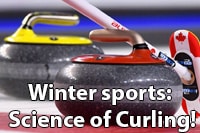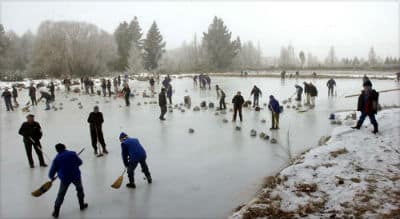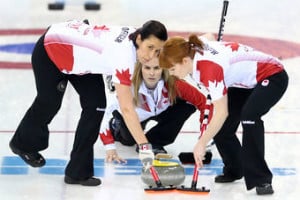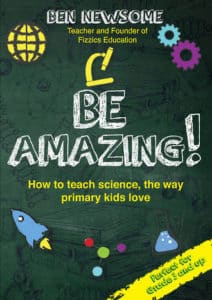
After the blazing hot heat waves we’ve had this summer in Australia, it’s hard to imagine that over in the Northern Hemisphere the Winter Olympic Games are about to begin! This is a great opportunity to investigate with your students the science involved in these sports. Understanding the fundamental scientific principles behind each sport can help athletes perform better, through improved technique or advancements in the development of equipment.
To kick off the Olympic Games season, we’re going to start with an event that I have always found weird and wonderful and fascinating: Curling!

Curling on an iced-over lake in Naseby, New Zealand
(Source: Te Ara website).
Curling was thought to have originated in Scotland back in the 16th century. It’s no wonder that this curious sport is alive and well in the Scottish-settled regions of the world, including a quaint little town a couple of hours drive away from my hometown: Naseby. In winter when the nearby lake ices over, curling enthusiasts from all over show up to have a game or two! During the Olympic games however, the tournaments are held in ice rinks.
The aim of the game is simple: get as many heavy granite stones (which are almost 20 kg each!) as possible across a sheet of ice to a target area (the “house”). Two “sweepers” help the stones reach their destination by furiously polishing the ice in front of it. If your stones happen to knock your opponent’s stones out of the way while you’re at it, bonus! How bizarre!

Sweepers working hard to keep the stone moving straight and steadfast
(Source: Official Olympic Games website).
There is a tremendous amount of science involved in a game of curling:
- Curling is played on a bumpy ice surface, not smooth like other ice sports! This reduces the surface area contact between the stone and the ice sheet, and therefore friction. On top of that (or should I say, beneath?) the bumpy surface prevents a vacuum forming between it and the bottom of the stone. This way, air pressure can’t interfere with the momentum of the stone so it can travel further and faster!
- Historically, the brooms that the sweepers use to polish the ice are very much like the ones we used to clean our floors, so they can sweep away snow or debris that are in the way of the stones. Nowadays, they have a synthetic fabric on the bottom that is a little bit abrasive. This helps generate friction and therefore heat in order to slightly melt the surface of the ice. The thin film of water helps the stone glide effortless towards its target, since the stone will take the path of least resistance and friction!
- The stones themselves are very special. The granite used to make these stones only come from two places in the world, and it is hydrophobic. This means that the surface of the stones repel water, and can glide over the thin water film without being slowed down!
- How do you make sure that when your team’s stone collides with the other team’s stones, your stone stays in the “house” and theirs get knocked away? It’s all about understanding the transfer of kinetic energy and momentum! An object in motion has momentum, which is related to its mass and its velocity. This momentum is directional and can be transferred, but it also has to follow Newton’s third law of motion: For every action, there is an equal and opposite reaction. The athletes have to make sure that their stone has just enough momentum to pass it all onto the other team’s stone to make it move out of the “house”, without their own stone overshooting or rebounding in the wrong direction!
Happy teaching,
Learn more about ‘Forces, Friction and Movement’ with the Fizzics team!

NEW Primary science teaching book!
“Be Amazing! How to teach science, the way primary kids love”



























It was very interesting
That was very interesting it caught my attention . it was very nice to read about a new sport that i never heard about .